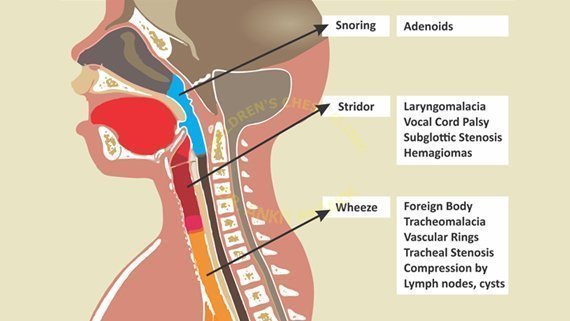
Noisy Breathing in Children: Understanding Stridor, Snoring, and Stertor
What Is Stridor?
Stridor is a high-pitched, harsh sound heard primarily during inspiration. It indicates an obstruction or narrowing in the upper airway, which includes the larynx or trachea. Stridor may be acute or chronic, depending on the underlying cause.
Common causes of stridor in children depends on the whether the stridor has been since birth (or first month of life) or later in life and whether it is short lasting or persistent:
Common causes of STRIDOR in young babies which are present since birth or first month of life:
- Laryngomalacia: Floppy laryngeal tissues that collapse during breathing, typically seen in infants.
- Subglottic stenosis: Narrowing of the airway below the vocal cords, often congenital or post-intubation.
- Vocal cord paralysis: movement of vocal cord is sluggish or absent
- Laryngeal webs
- Subglottic hemagiomas
Common causes of STRIDOR in older children are:
- Croup: A viral infection causing swelling in the upper airway.
- Foreign body aspiration: When an object gets lodged in the airway, causing sudden stridor.
Snoring and Its Significance
Snoring occurs when airflow through the nose or mouth is partially obstructed during sleep. While occasional snoring due to a cold or allergies is common, habitual snoring can signal underlying issues like:
- Enlarged tonsils or adenoids.
- Obstructive Sleep Apnea (OSA): A condition causing repeated pauses in breathing during sleep.
- Allergies or nasal congestion.
Chronic snoring can affect a child’s sleep quality, behavior, and even growth, making it essential to seek medical advice if it persists.
What Is Stertor?
Stertor is a low-pitched, snoring-like sound that occurs due to obstruction in the nasopharynx or oropharynx. Unlike stridor, stertor is heard during both inspiration and expiration and is often described as a "snoring" sound during wakefulness.
Common causes of stertor include:
- Nasal congestion or polyps.
- Enlarged adenoids or tonsils.
- Structural abnormalities in the nasal or oral cavities.
When to Seek Medical Help
Noisy breathing in children, especially persistent or severe forms, warrants prompt evaluation by a pediatric pulmonologist.
Some red flags include:
- Persistent stridor, particularly if it worsens or is accompanied by difficulty breathing, chest indrawings or retractions during breathing, poor weight gain, weak cry, child getting blue (cyanosis), feeding difficulty like choking
- Habitual snoring with signs of disturbed sleep or daytime fatigue.
- Stertor that interferes with feeding, sleeping, or breathing.
Bronchoscopy
Bronchoscopy is a valuable diagnostic tool in such situations. This procedure involves inserting a flexible tube with a camera into the airway to visualize and assess abnormalities. Some children might require additional investigations like CT scan of neck or chest, barium studies etc.
Noisy breathing in children, whether it manifests as stridor, snoring, or stertor, is not uncommon but should not be ignored. Identifying the type of noisy breathing and understanding its potential causes can help guide appropriate care.
If your child experiences persistent noisy breathing, consult a pediatric pulmonologist for a thorough evaluation and tailored treatment.Conclusion
Related Video
Frequently Asked Questions (FAQs)
1. How can I differentiate between stridor, snoring, and stertor?
Stridor is a high-pitched sound heard during inspiration due to upper airway obstruction. Snoring occurs during sleep due to partial nasal or oral airway blockage. Stertor is a snoring-like sound heard during both wakefulness and sleep, caused by obstructions in the nasopharynx or oropharynx.
2. What is the difference between stridor and wheezing?
Stridor is a high-pitched sound heard during inspiration due to upper airway obstruction, while wheezing is a whistling sound heard during expiration, typically caused by lower airway issues like asthma.
3. Can snoring in children resolve on its own?
Occasional snoring may resolve, especially if caused by temporary factors like a cold. However, habitual snoring should be evaluated for conditions like OSA or enlarged tonsils.
4. Is noisy breathing always a sign of a serious problem?
Not always. Mild conditions like a cold or minor allergies can cause noisy breathing. However, persistent or severe symptoms may indicate an underlying issue requiring medical attention.
5. What are the treatment options for stridor?What are the treatment options for stridor?What are the treatment options for stridor?
Treatment depends on the cause. Croup may require medications like steroids or nebulized epinephrine, while structural issues may need surgical intervention.



